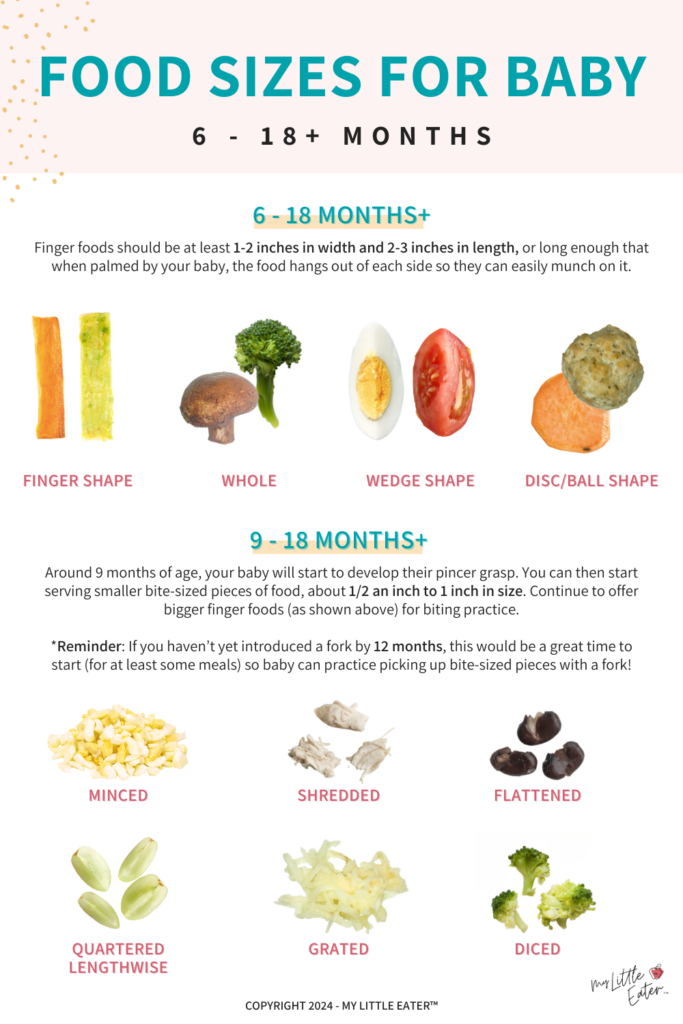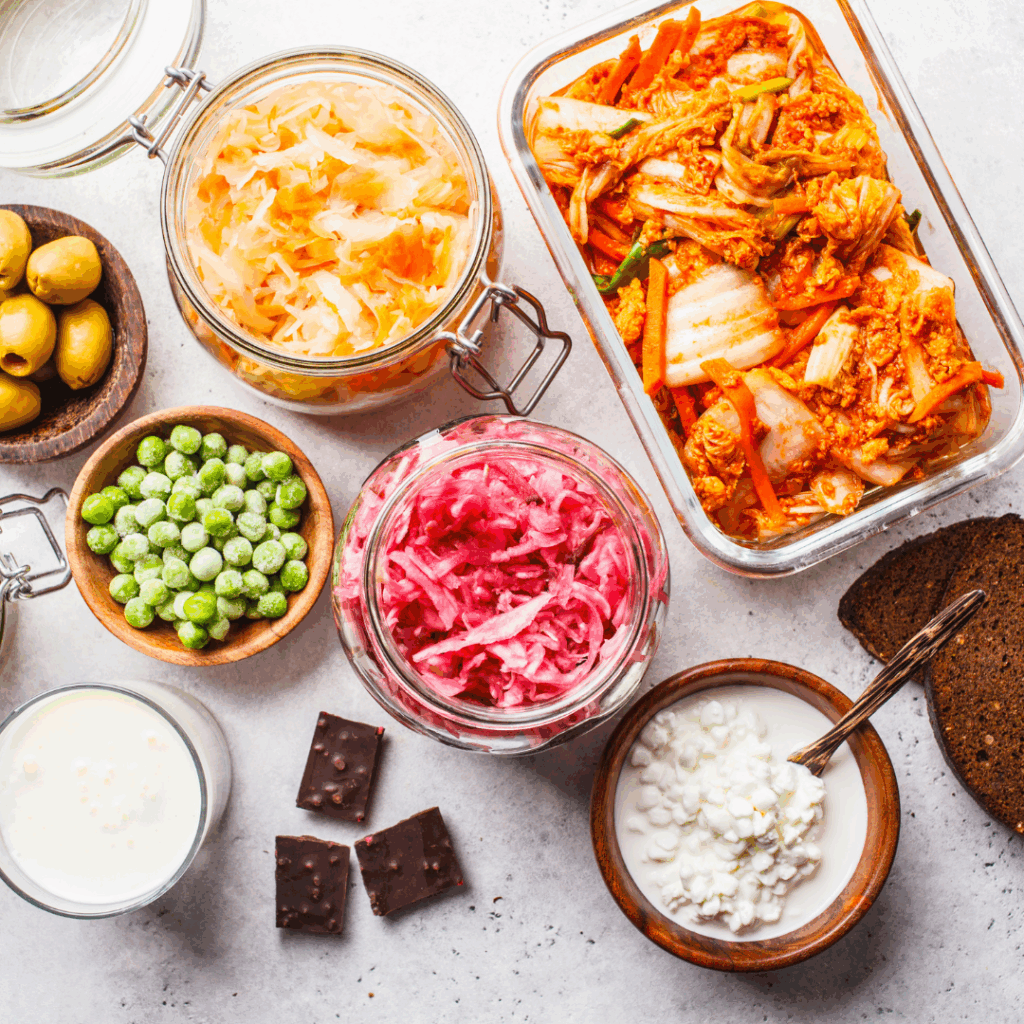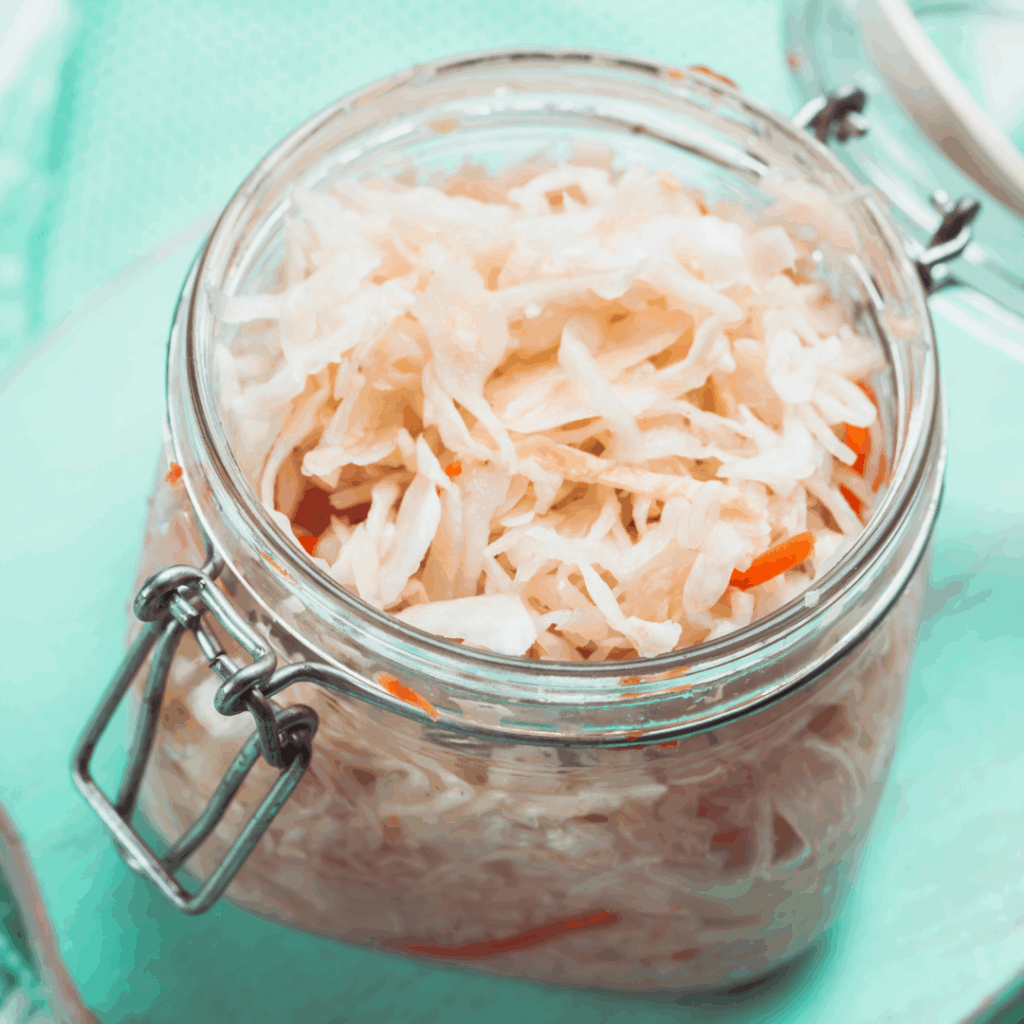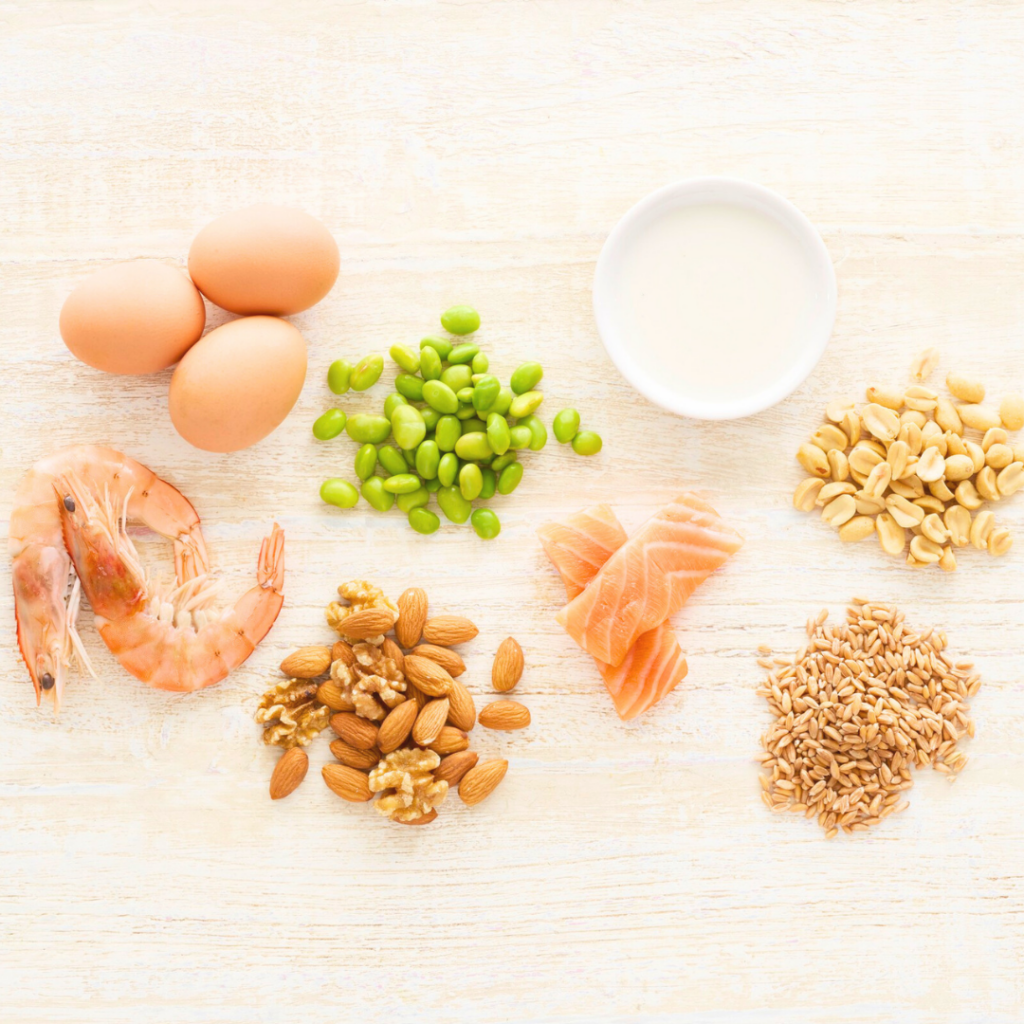“But what if they choke!?”
This is the reaction we get from a lot of concerned parents when we suggest offering larger-sized pieces of food to their 6 month old baby.
Although it seems counterintuitive, small pieces of food can sometimes be more of a choking hazard – especially when first introducing solids!
We’re here to teach you the logic behind why big foods can be safer and more beneficial in the beginning. We’ll also address how to make big pieces safe, what to do if baby has teeth – and – we’ve even got a baby food size chart to share. Let’s get started!

PS – Sign up for our FREE workshop to help you overcome your fear of gagging, choking, and taking big bites of food. We give you our best tips for how to remove any anxiety around gagging, and will cover how to gradually advance from purees to solids at a pace that works for you and your baby – without the fear!

Table of Contents
What size should food be for babies?
When introducing finger foods to babies at 6 months, start with bigger and longer pieces of food. Finger foods should be approximately 1-2” wide and about the length of an adult index finger. This is the shape that’s easiest for your baby to pick up and hold with their palmar grasp.
The palmar grasp is the ability for your baby to hold an object in their hand by wrapping their fingers around it and stabilizing it against their palm. This skill starts to emerge around 4 months of age, and is perfected by 6 months of age.

Around 9 months of age, you can start offering small, bite-sized pieces of food. This is because they now start to develop the pincer grasp! The pincer grasp is the ability to pick up small objects between your thumb and forefinger. You can begin offering food like cooked beans, blueberries, or pieces of ground meat at this stage.
Of course, you should still continue to offer some bigger, finger-shaped pieces of food as well. This way, they can continue to practice holding and taking bites out of larger pieces of food, while also learning how to manage small pieces.
The best food shapes for babies
There is no, one “best” shape of food to offer your baby.
While longer finger or stick-shaped foods are a great option, you can also offer disc shapes, wedges, and even some whole pieces of food like ripe fruits!

However, the way food is cut and served really depends on the type and how it’s cooked. This is what determines the risk of choking. Knowing when it’s ok to serve food in larger pieces, and what shape is safe to serve them in, can sometimes be tricky.
We created our Texture Timeline™ video library (inside the Baby Led Feeding online course) for this reason! It allows you to search for any food and see on video how to serve it safely, based on age and stage of difficulty. It also includes nutritional and allergy info on each food.
Baby food size chart (6-18+ months)
Our goal is to have you serve foods that are appropriate for baby’s developmental stages so they aren’t missing out on opportunities to learn, practice, and advance their skills.
Giving baby a tiny piece of food that they will never be able to pick up and get into their mouth isn’t going to help them advance their eating skills. It will simply cause frustration and potentially a negative association with meal time.
The opposite is also true if you never offer bite-sized pieces. They will miss out on learning how to use fine motor skills to pick up food, and move their tongue around to position and chew small pieces. The image below shows appropriate food shapes and sizes based on baby’s age and developmental stage.
Make sure you click the image to download it, pin it to Pinterest, or take a screenshot so you always have it to refer to!
Why you need to serve big pieces of finger foods at 6 months
Parents are usually very concerned about serving bigger pieces of food to baby when they first start solids. It may seem like small, bite-sized pieces are easier or safer for baby, but in fact, offering bigger pieces of food at 6 months can be safer, promotes the development of motor skills and hand-eye coordination, and encourages self-feeding.
Let’s get into the details!
1. Bigger pieces of food can be safer
Bigger pieces of food are easier for baby to hold onto when first starting solids and offer a certain level of safety, as they can choose to pull it out of their mouth if they want or need to. Babies can also direct where it goes in their mouth by using their hands to “steer” it, essentially learning how to map out the boundaries of their mouth.

This is especially true with a large, hard, and resistive finger food like a spare rib bone or a mango pit (phase 0 finger foods on our Texture Timeline™). These foods are safe as they can’t take bites out of them, and yet, they’re a great way for baby to practice moving their tongue, jaw, and lips around a piece of food that can’t be choked on.
Larger pieces of food are also much easier to locate and feel in the mouth and harder to lose track of, compared to a tiny piece of food. Even when a large piece of food is bitten off, it’s much easier to isolate it and gag or spit it out. It’s also easier to move it over to the side of the mouth to mash it down and make it more manageable.

Compare that with a bite-size piece of food – say – a grain of rice or a cooked pea. The ability for a baby to be able to map out where on their tongue or inside of their cheek that tiny piece of food is, is incredibly difficult and requires a lot of coordination.
As new eaters, babies do not have the coordination in their mouth muscles to do anything but suck and swallow in the beginning. It takes many months for babies to learn how to gain enough control with their tongue to be able to “sweep” a piece of food out of the side of their mouth, onto the center of their tongue, push it up against the roof of their palate or top lip, and spit it out properly.

2. Bigger pieces of food develop motor skills and hand-eye coordination
Babies use a combination of arm, hand, and finger movements when learning how to self-feed (1).
Hand-eye coordination is the ability of your hands and eyes to work together. Bigger pieces are a lot easier for baby to see (compared to a small, bite-sized piece of food). This means baby can coordinate hand movement based on what they’re seeing with their eyes with more accuracy.

Gross motor skills are the abilities needed to control the larger muscles in the body (1). These muscles include the arms, legs, and torso (1). Allowing baby to self-feed with bigger finger foods means they need to reach out for that food with their arms, while also supporting themselves to remain upright with their legs and torso during mealtime.
Fine motor skills use smaller muscles in the body like our hands and fingers, and they’re dependent on the development of gross motor skills (1). Fine motor skills include the ability to reach out for food with one hand, transfer food from hand to hand, and use a raking motion to pick up food (1).

With bigger pieces of food, baby is learning how to move the food around in their palms to get better access to it. They’ll also learn which foods need one hand and which need two to hold them up – which would not be possible with bite-sized pieces.
All of these complex movements required for baby to self-feed contribute to proper development of hand-eye coordination, gross and fine motor skills (2, 3).
3. Bigger pieces of food encourage self-feeding

Offering baby appropriate-sized finger foods encourages them to self-feed and be in control of the feeding process, which comes with a host of benefits. By allowing baby to be in control, they can completely regulate how much they want to eat, reducing the risk of under or overeating. It also makes mealtimes generally pleasant for them since they can control the experience.
By determining the pace of the meal through self-feeding, they’re developing their independence. Paired with the motor and oral skill development it also promotes, there may be long-term benefits for preventing future food refusals and picky eating in toddlerhood (2, 4).
What if baby gags or chokes on big pieces?

Your baby may gag on large pieces of food in the beginning, which is expected, totally normal, and all a part of the learning process. Although nerve-wracking at times, we want babies to gag to help them learn how to advance their skills. It’s important to remember two things:
- Gagging does not mean that your baby’s choking. Your baby isn’t in danger when they’re gagging and gagging doesn’t cause choking. Their airway is open and clear and they’re just sorting out what they need to do to get the food either out of their mouth or repositioned for a better chew or swallow.
- Do not intervene with a gagging baby. If your baby is gagging, don’t try to sweep your finger in their mouth to get out a big piece of food. This could move it past their gag reflex and push it further into their mouth, causing choking. Let your baby use their strong gag reflex to bring that food to the front of their mouth or completely out of their mouth.

Remember – if a food is served safely (squishable and served in an appropriate shape), then your baby can safely manage it with a very, very low risk of choking. This goes for a big piece of food in their mouth, or a smaller piece of food that they break off of an initially large piece.
The truth is, there is no way to escape gagging! Even small pieces of food (like rice) or lumpy purees, can cause a baby to gag. The best thing you can do is get comfortable with gagging and be your baby’s cheerleader!
If you’re terrified by the idea of gagging and (obviously) choking when feeding solids, take our free workshop on how to overcome the fear of gagging and move your baby from easy to more advanced textures!
How to keep big pieces of food safe for babies

How you prepare and serve each food safely largely depends on the type of food it is. For example, hard fruits and veggies need to be cooked until soft, meat should be cooked slowly and kept moist, bread needs to be lightly toasted, etc.
It can be hard to know how to prepare all different types of foods for baby in the safest way possible, so that’s why we’ve developed the Texture Timeline™ food library inside our Baby Led Feeding course. This database allows you to search a food and see exactly how to prepare it in easier to more advanced ways so that it’s safe for your baby no matter what texture stage they’re in!
Some general rules to keep in mind to keep food safe for baby include keeping foods moist and tender, using the squish test, and eating with your baby.
Keep solid foods moist and tender
This helps ensure the foods eaten are safe and easy for baby to swallow. Large strips of meat in particular can be a choking hazard for baby if not prepared correctly. We recommend slow-cooking meat with a broth or sauce as it produces really tender, moist pieces of meat for your baby.
Learn more about the most tender cuts of meat for your baby.
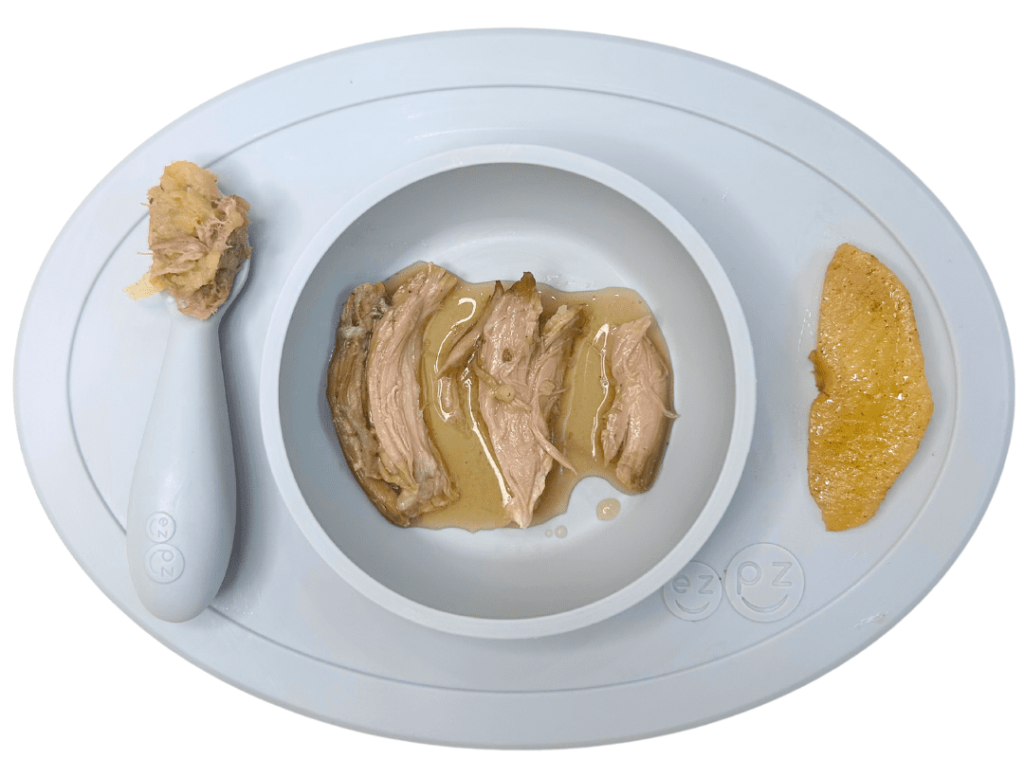
Use the squish test
Generally speaking, to determine whether or not the texture of a finger food is safe for baby led weaning, it should be soft enough to pass what we call the “squish test”.

If you can put food between your thumb and forefinger and squish down gently to smush the food between those two fingers, a food is soft enough for your baby. This is because this test mimics the pressure a baby is able to exert with their gums while eating. Actually, their gums are even stronger than the pressure between our thumb and forefinger, so this is a conservative approach!
Eat with your baby
To keep your baby safe, it’s important to sit down and eat with them so they’re never left unsupervised. It may be tempting to walk away and do some dishes or clean up the kitchen while baby is munching on some finger foods, but we highly recommend waiting until baby is done eating to do this.
This is because if they started choking you wouldn’t be there to intervene immediately. You may even be unaware that your baby is choking for a prolonged period of time, as choking is typically silent.

Eating with your baby is also beneficial for modeling safe eating habits and helping babies learn how to eat. Babies learn extremely well through imitation by watching us eat!
When can babies have bite-sized pieces of food?
As mentioned above, babies don’t develop their pincer grasp until about 8-9 months of age. Around that time, you’ll see them starting to use their pincer grasp to pick up small toys during playtime which is a good sign that they’re ready to start practicing eating bite-sized pieces of food.

Offer bite-sized pieces for baby to practice alongside longer finger-shaped foods. They’ll need time to master this new skill, but again, you can help them learn by modeling how to pick up smaller pieces of food during mealtime.
Note: Once your baby has mastered their pincer grasp, it doesn’t mean you have to stop offering finger-shaped foods for baby led weaning. It’s best to alternate how foods show up to ensure baby is being exposed to familiar foods in different shapes and sizes.
FAQs on BLW food size
What if my baby bites off big pieces?
If baby bites off a large piece of a finger food while eating solids, a few things can happen.
- If it’s squishable, they can mash that food down in their mouth, making it no different than if they were to mash any other solid food eaten off a spoon.
- If their body’s messaging is saying that they’re not ready to chew it yet, their gag reflex will kick in and be there to protect them. This will cause them to spit food out or reposition it instead of attempting to swallow it.
- You can model chewing with big exaggerated “CHOMPS” with food in your own mouth to help baby learn to chew and break down those larger pieces of food until they’re safe enough to swallow.
What if my baby breaks the big piece into smaller pieces, is it no longer safe?
If your baby can break the finger food into smaller pieces with their hands, it’s probably soft and squishy enough for them to mash with their gums. When you start baby led weaning, they won’t have the ability to pick up these smaller pieces, they’ll need their pincer grasp for that.
However, if they do have their pincer grasp at that point, it is safe for them to eat those smaller pieces of soft foods. If you’re worried, feel free to take away the smaller broken pieces of solid food and let baby continue with the bigger pieces.
What if my baby doesn’t have teeth?
Despite popular belief, babies don’t actually need teeth to eat finger foods! Their gums are incredibly strong which allows them to mash up food using a munching up and down motion. You can use the squish test mentioned above as a way to gauge whether or not foods for baby are soft enough to eat.
What if my baby has teeth at 6 months?
If your baby already has teeth by 6 months when they start eating solids, there are some whole, hard resistive foods (like raw carrot, cucumber spears, etc.) that should be avoided. This is because they could bite a piece off, which would then become a choking hazard for baby. Read our blog post to learn more about the various choking hazards for babies.
However, you can still serve other finger foods that pass the squish test and continue to model chewing at mealtime to help baby learn how to chew when they bite pieces off.
What if baby can’t pick up a piece of food?
Babies need to learn how to pick up food, which requires some practice. Slippery foods like bananas and avocado (commonly served as first foods) can be extra difficult. Some babies will get the hang of it quickly, while others need more time to master this new skill. Consistent practice is key!
We don’t recommend putting finger foods into baby’s mouth as this can increase the risk of choking. Instead, you can hold it up for them in their line of vision, and support it in your hands as they bring their mouth onto the food and take bites. As long as they’re in control of those bites or sucks, you can help them out this way for a short time as they figure out how to hold it.
Are there any foods that are not safe for baby led weaning?
All high-risk choking hazards should be avoided or modified safely before being offered to baby. The biggest thing to think about when determining if something is a choking hazard is: “Is this a texture that can easily get lodged in my baby or toddler’s airway when swallowed whole (or parts of it are broken off?).”
Solid foods are especially dangerous if they’re small and round shaped, as this can more easily block off all air in the airway if swallowed whole. This is especially risky for hard foods because they’re more difficult for babies and toddlers to break down due to limited chewing skills.
A baby’s airway is about the size of your pinky finger or the size of the opening of a typical drinking straw. You can use that as a guide to determine if it needs to be modified in shape, or avoided altogether.
If you’re still feeling worried about offering finger foods to your little one – don’t forget about our free workshop – “Baby Led Weaning (but make it purees!) How to progress from purées to finger foods…without the fear!”.
In the workshop, we teach you about our signature Texture Timeline™ which allows you to introduce foods gradually, either purees or finger foods, at a pace that works for you and your baby so you can eliminate any fear of gagging, choking, or big bites. Spots are limited, so reserve your seat now!

References:
- Campeau, M., Philippe, S., Martini, R., & Fontaine‐Bisson, B. (2021). The baby‐led weaning method: a focus on mealtime behaviours, food acceptance and fine motor skills. Nutrition Bulletin, 46(4), 476-485.
- Rapley, G., Forste, R., Cameron, S., Brown, A., & Wright, C. (2015). Baby-Led Weaning: a new frontier?. ICAN: Infant, child, & Adolescent Nutrition, 7(2), 77-85.
- Gerber, R. J., Wilks, T., & Erdie-Lalena, C. Developmental milestones: motor development. Pediatrics in review, 31(7), 267-277, 2010.
- Brown, A., & Lee, M. D. (2015). Early influences on child satiety‐responsiveness: the role of weaning style. Pediatric obesity, 10(1), 57-66.
Is THIS HELPFUL? PIN IT TO SAVE FOR LATER!


CHELSEY LANDRY, RD
Community Dietitian at My Little Eater Inc., and bunny-mom to Hickory. Chelsey offers one-on-one counselling to parents of babies and toddlers that need more customized support. Learn more by booking a free discovery call with her today!

CHELSEY LANDRY, RD
Community Dietitian at My Little Eater Inc., and bunny-mom to Hickory. Chelsey offers one-on-one counselling to parents of babies and toddlers that need more customized support. Learn more by booking a free discovery call with her today!
